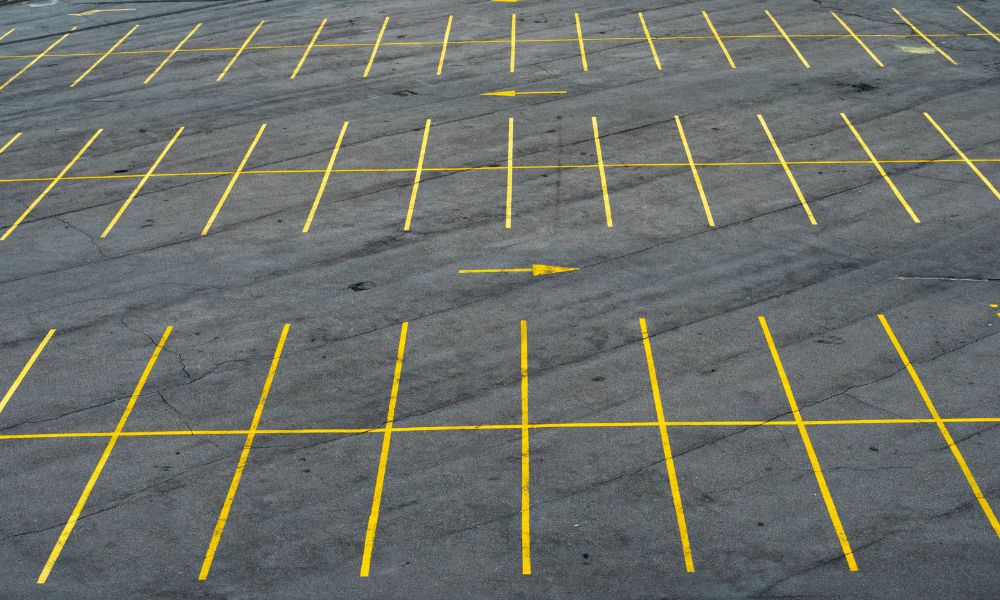Comprehending the Value of Road Painting in Urban Facilities Development
The duty of roadway painting in metropolitan infrastructure development expands past simple appearances, offering as a fundamental component in boosting safety and maximizing web traffic flow (Road painting near me). Reliable road markings not just supply critical guidance for both chauffeurs and pedestrians however likewise contribute to the overall capability of city spaces.
Safety Enhancements Through Road Markings
Often forgotten in city framework advancement, road markings play a crucial duty in boosting security for both vehicle drivers and pedestrians. These markings work as crucial visual cues that assist vehicle activity and establish order on highways. Effectively developed and kept road markings communicate important info, such as lane boundaries, pedestrian crossings, and quit lines, effectively minimizing the chance of mishaps.
The visibility and clearness of road markings are critical, particularly in adverse weather condition conditions. Reflective paints and high-contrast materials help make sure that markings stay noticeable at evening and during stormy conditions, therefore improving security results. Furthermore, the application of standardized icons, such as arrows and pedestrian icons, fosters far better understanding amongst road customers, advertising compliance with web traffic laws.
In addition to their functional aspects, roadway markings add substantially to the overall visual of city environments. Well-executed road paint boosts the visual charm of streetscapes while simultaneously enhancing the value of roadway security. As cities remain to expand and progress, prioritizing the high quality and maintenance of roadway markings is vital in promoting a risk-free and effective transport system for all individuals.
Influence On Web Traffic Flow
Maximizing website traffic circulation is substantially influenced by the strategic application of roadway markings. Correctly created and preserved road markings supply crucial guidance for drivers, facilitating smoother navigation via various website traffic scenarios. By clearly delineating lanes, showing turning points, and marking junctions, roadway markings assist decrease confusion and avoid crashes, eventually boosting general website traffic effectiveness.
Furthermore, roadway markings play a pivotal duty in controling automobile speeds. The use of lane reduction markings and speed up limit signs can affect chauffeur habits, urging adherence to risk-free driving practices. This, consequently, reduces congestion and advertises a much more fluid activity of cars.
Furthermore, well-placed road markings can improve the performance of traffic signals and indications. By guaranteeing that these components are aesthetically strengthened through suitable sidewalk markings, chauffeurs get coherent and consistent information, permitting even more educated decision-making.
In urban environments, where website traffic density is high, the integration of advanced road paint techniques, such as thermoplastic and reflective materials, can further enhance presence under different climate conditions. In summary, reliable road markings are critical for optimizing website traffic flow, adding to more secure and much more efficient city transport systems.
Supporting Pedestrian Navigating
Efficient roadway markings are crucial for sustaining pedestrian navigation, particularly in urban locations where foot traffic is substantial - Pavement marking. Clear, well-defined crosswalks, directional arrowheads, and pedestrian signs enhance visibility and overview pedestrians securely throughout roadways. These markings educate pedestrians of their right-of-way, decreasing the likelihood of accidents and boosting total safety and security
Moreover, efficient road painting can mark various areas within the urban environment, such as separating pedestrian courses from car lanes. This delineation cultivates a safer strolling experience, urging boosted foot traffic and promoting urban vitality. Markings that assign pedestrian-only locations or shared areas further enhance their website navigating by clarifying where pedestrians can safely go across without disturbance from vehicles.

View Line painting Abbotsford in a full screen map
Aesthetic Contributions to Urban Style
The aesthetic payments of road paint substantially boost city design, changing average roads into aesthetically engaging areas. Attentively developed street markings and dynamic shades develop an aesthetic narrative that can reflect the identification of a neighborhood. Imaginative crosswalks, for instance, not just serve their functional function but likewise act as public art installations, urging neighborhood communication and satisfaction.
Furthermore, the tactical usage of shade can influence assumptions of security and ease of access. Brightly painted bike lanes and pedestrian areas can mark rooms, making them much more appealing and urging their use. This, in turn, fosters a feeling of neighborhood by find out promoting energetic transportation settings, such as walking and biking.
Additionally, road paint plays a crucial role in city revitalization initiatives. Ultimately, the visual payments of roadway paint are crucial for the creation of vivid, livable city spaces that reverberate with the area's personality and ambitions.
Environmental Considerations in Roadway Painting

To minimize these issues, the fostering of eco-friendly alternatives is essential. Water-based paints and those made from lasting materials help in reducing VOC emissions and enhance general environmental influence. Furthermore, reflective and thermoplastic markings can boost exposure while minimizing the necessity for frequent repainting, therefore minimizing product usage with time.
Furthermore, roadway painting can be incorporated with city eco-friendly efforts, such as making use of permeable products that permit rain to penetrate, therefore lowering runoff and advertising groundwater recharge. In summary, while roadway paint is essential for urban functionality, it is important that environmental factors to consider guide material choice and application approaches to ensure lasting metropolitan advancement.
Conclusion
To conclude, roadway paint plays a crucial function in city infrastructure advancement by enhancing safety and security, optimizing traffic circulation, and supporting pedestrian navigating. The consolidation of visual aspects additional improves city style, promoting neighborhood engagement and satisfaction. In addition, interest to environmental considerations in road paint adds to lasting metropolitan advancement. Generally, efficient road marking is important for producing secure, efficient, and lively city spaces that satisfy the demands of all customers.
